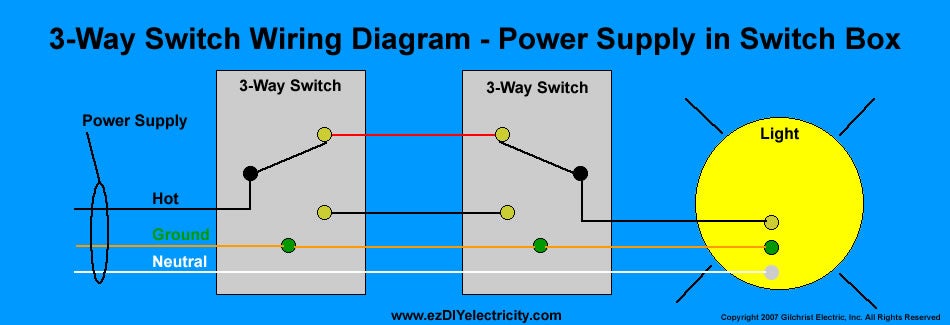Hi guys, I hope you don't mind if I jump in here, as I've recently purchased a few sets of these 3-way dimmer sets. I too am a novice when it comes to wiring, but have installed/replaced many standard 2-way and 3-way switches in the past without much problem and I understand the basics of home wiring, including a little about 3-way/4-way wiring. But mostly, I'm just good at following direction when it comes to this stuff.
When I built my house, I had asked for all my boxes to have a neutral AND for my lights to be the last in the chain of switches, so that it would go Power --> Switch --> Switch --> Load/Light.
So, I'm trying to figure out how to wire these correctly... currently my three way wiring uses this approach:
http://www.diychatroom.com/attachments/f18/16702d1263774538-3-way-switch-installation-ti070-3w-aube-3-way-switch-wiring-diagram.jpg
... to the best of my knowledge.
Switch 1's box - has Black (line/hot), Ground, and Neutral (white) and Black and Red travelers
Switch 2's box - has the travelers coming in, then Black (Load), ground, and neutral (white)
So, If you read that from Left to Right, would the appropriate way to hook up the GE switches be:
PS to Switch 1
Switch 1 - Aux switch
Black (Line/Hot) - to White/Red Aux Switch Wire
Red Traveler - to Yellow Aux Switch Wire
Black Traveler - NOT USED ?
Ground - to Green Aux Switch Wire
Neutral - NOT USED
Switch 2 - Primary Switch
Black (Load) - to Black Primary Switch Wire?
Black (Load) - to Blue Primary Switch Wire?
Black Traveler - NOT USED ?
Red Traveler - to Yellow Primary Switch Wire
Ground - to Green Primary Switch Wire
Neutral - to White Primary Switch Wire
to
Light (Load)
Am I even close to being correct? Let me know if I can provide any more details (or if I should spin this question off in its own thread.
BTW - here's the PDF to the installation manual for those of you who would like to take a better look - http://www.jascoproducts.com/support/manual-downloads/applications/DocumentLibraryManager/upload/45613-Manual-Eng.pdf
Thanks!
:::EDIT:::
Actually, I'm wondering if this would be more correct... basically hook the black traveler cable into the black hot in box 1, so at box 2 the black traveler cable is the hot needed to hook to the black wire on switch 2. Again, just trying to figure this wacky wiring system out :S
PS to Switch 1
Switch 1 - Aux switch
Black (Line/Hot) - to White/Red Aux Switch Wire
Red Traveler - to Yellow Aux Switch Wire
Black Traveler - Wired to Black (Line/Hot)?
Ground - to Green Aux Switch Wire
Neutral - NOT USED
Switch 2 - Primary Switch
Black (Load) - to Blue Primary Switch Wire?
Black Traveler - Black Primary Switch Wire?
Red Traveler - to Yellow Primary Switch Wire
Ground - to Green Primary Switch Wire
Neutral - to White Primary Switch Wire
to
Light (Load)

